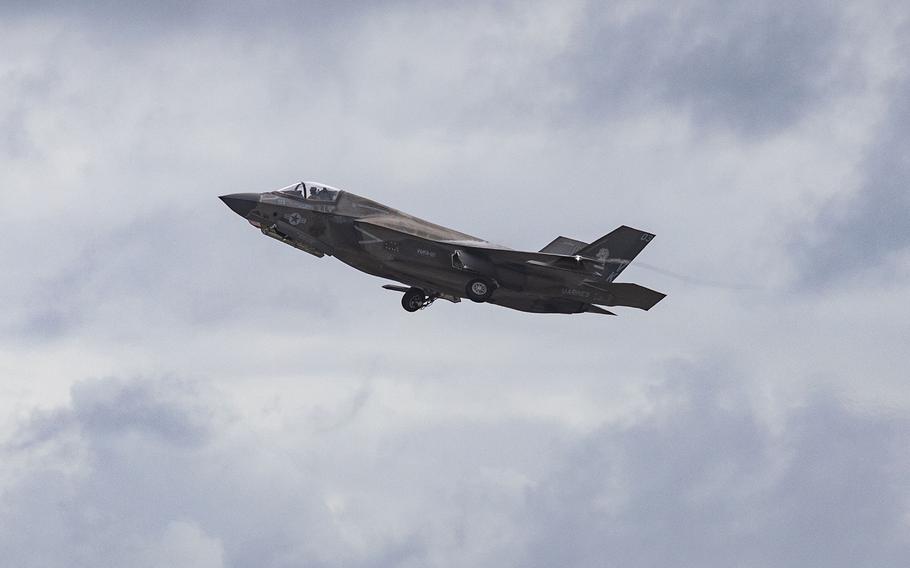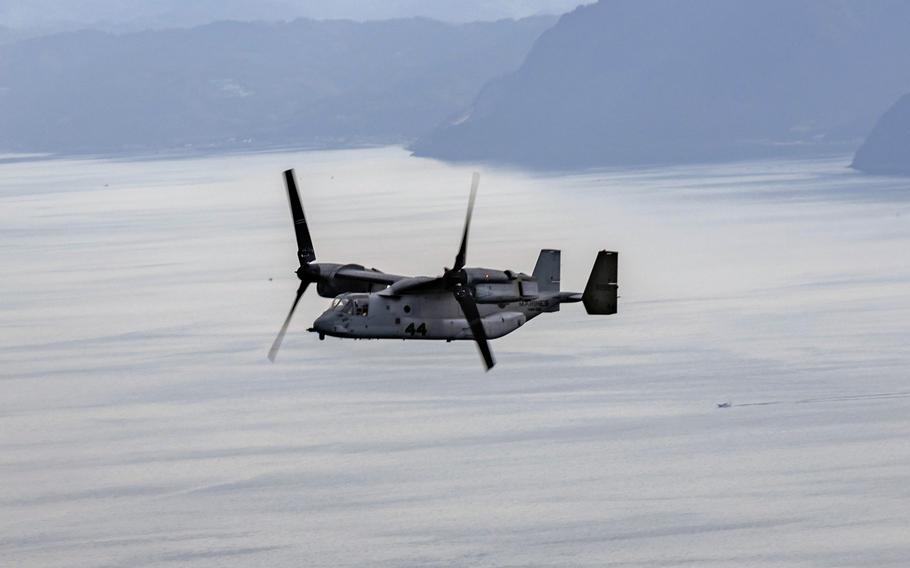
An F-35B Lightning II with Marine Fighter Attack Squadron 121 takes off for a Cope North drill at Andersen Air Force Base, Guam, on Feb. 5, 2025. (Dahkareo Pritchett/U.S. Marine Corps)
Two Marine Corps aircraft made separate precautionary landings in Japan on Tuesday in response to cockpit warning indicators, according to service spokesmen.
An F-35B Lightning II multirole fighter landed in southern Japan, and an MV-22B Osprey put down 120 miles west of Tokyo. Both aircraft landed without incident at city airports, according to the Marines.
The F-35B, assigned to Marine Fighter Attack Squadron 121 at Marine Corps Air Station Iwakuni, landed first at 1:58 p.m. at Kochi Airport in Kochi prefecture, 1st Marine Aircraft Wing spokesman Maj. Joseph Butterfield wrote in an email Wednesday.
Around 3 p.m., an Osprey with Marine Medium Tiltrotor Squadron 262 at Marine Corps Air Station Futenma landed at Matsumoto Airport in Nagano prefecture, 31st Marine Expeditionary Unit spokesman Maj. Edward Pingel wrote in an email Wednesday.
Both aircraft were on routine training flights when their pilots received warning indications. No injuries or damage to the aircraft or airports occurred, both spokesmen said.
Kochi prefecture is on Shikoku, the smallest of Japan’s four main islands. Nagano prefecture is west of Tokyo on Honshu, the largest of the four islands.

A Marine Corps MV-22B Osprey participates in the Iron Fist exercise off the coast of Japan on Feb. 23, 2025. (Tyler Andrews/U.S. Marine Corps)
Maintenance and troubleshooting on the F-35B was underway Wednesday morning “in preparation of the aircraft’s safe return to station,” Butterfield said.
“The pilot performed as trained and prioritized safety by landing the aircraft in accordance with standard procedures,” he wrote. “… Any decision to divert to alternate landing areas is made out of an abundance of caution to prioritize the safety of both our aircrew and the local community.”
No commercial flights were affected at Kochi, a Chugoku-Shikoku Defense Bureau spokesman said by phone Wednesday.
A second Osprey accompanying the first landed at 3:35 p.m. and took off five minutes later, according to a news release from Nagano prefecture. The airport runway closed for 45 minutes beginning at 3:45 p.m., according to the release.
The first Osprey was still at the airport Wednesday morning, a spokesman with the North Kanto Defense Bureau said by phone that day. Some Japanese government officials may speak to the press only on condition of anonymity.
“The crew is conducting thorough troubleshooting to ensure the safety of continued flight operations,” Pingel said.
One commercial flight inbound from New Chitose Airport in northern Japan diverted to Nagoya Airport in Aichi prefecture, and an outgoing flight to New Chitose was canceled, according to the release.
“I apologize to the citizens of the prefecture and people using Matsumoto airport for the anxiety this is causing,” Nagano Gov. Shuichi Abe said in a statement posted to the prefecture’s website Tuesday. “We are asking the North Kanto Defense Bureau to collect and share detailed information and to deal with this appropriately to ensure safety.”
The revolutionary aircraft takes off and lands like a helicopter but flies like a fixed-wing aircraft.